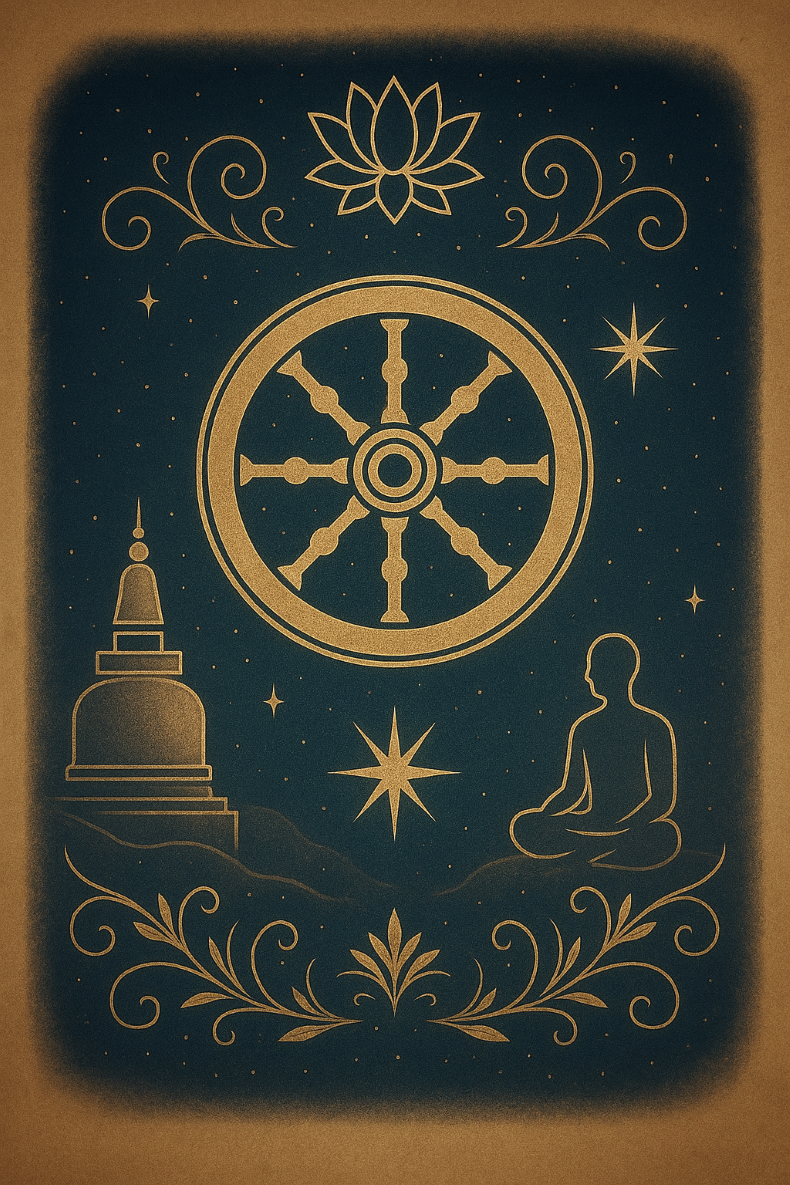 | Buddhism |  |

A Path of Mindfulness, Compassion, Wisdom, and Inner Peace
Buddhism is a spiritual and philosophical tradition focused on understanding the mind, reducing suffering, and cultivating compassion and clarity. Rather than worshiping a deity, most Buddhist paths emphasize awareness, ethical living, and personal transformation through practice.
This path is ideal for those seeking inner peace, mindful living, emotional clarity, and spiritual growth without rigid doctrine.
🍃1. What This Path Is🍃
Buddhism includes many branches and interpretations, such as:
- Zen Buddhism (simplicity, meditation, presence)
- Tibetan Buddhism (visualization, mantra, ritual)
- Theravada Buddhism (early teachings, mindfulness)
- Secular / Modern Mindfulness (non-religious practice)
Across its many forms, Buddhism is rooted in:
- Understanding the nature of suffering
- Developing wisdom and compassion
- Observing the mind
- Living ethically
- Practicing mindfulness
- Seeking liberation and inner freedom
There is no single way to “be Buddhist” – only practices that help you awaken to your true nature.
📖2. Core Beliefs📖
While the details vary across traditions, foundational Buddhist teachings include:
- The Four Noble Truths
- Life contains suffering or dissatisfaction
- Suffering has causes (craving, ignorance, attachment)
- Suffering can be transformed
- The path to transformation is the Noble Eightfold Path
- The Noble Eightfold Path
- Right view, intention, speech, action, livelihood, effort, mindfulness, concentration
- Impermanence – everything changes
- Interconnection – all beings affect each other
- Compassion – kindness as a spiritual practice
- Karma – actions have consequences
Buddhism is more about practice than belief.
It does not require worship, conversion, or dogmatic acceptance.
📜3. Sacred Texts & Sources📜
Common Buddhist sources include:
- The Pali Canon (Theravada)
- The Mahayana Sutras (e.g., Lotus Sutra, Heart Sutra)
- The Tibetan Book of the Dead
- Zen teachings and koans
- Modern teachers & commentaries
But equally important are:
- Meditation
- Direct experience
- Personal insight
- Observing one’s own mind
For many practitioners, the practice is the scripture.
🧙♀️4. Deities, Guides & Archetypes🧙♀️
Buddhism is filled with symbolic and historical figures that represent inner qualities:
- Siddhartha Gautama (The Buddha)
- Symbol of awakening and human potential
- Kuan Yin / Avalokiteshvara
- Compassion, mercy, emotional healing
- Tara
- Protection, compassion, swift action
- Bodhisattvas
- Beings dedicated to helping others awaken
- Arhats and monks
- Models of discipline and mindfulness
- Zen Masters
- Teach through paradox and presence
These figures represent qualities already inside you waiting to be awakened.
🌟5. Symbols & Their Meanings🌟
Common symbols include:
- The Dharma Wheel — the Eightfold Path
- The Lotus — purity, awakening, rising from difficulty
- The Buddha Image — peace, clarity, compassion
- The Endless Knot — interconnection, karma
- The Bell & Vajra — wisdom and method
- Prayer Flags — blessings carried by the wind
These symbols invite mindfulness and reflection.
🔥6. Rituals & Practices🔥
Buddhist practice centers on training the mind through:
- Meditation (breath, mindfulness, open-awareness)
- Loving-kindness (Metta)
- Walking meditation
- Chanting or mantra
- Visualization practices (especially in Tibetan Buddhism)
- Ethical reflection
- Journaling about thought patterns
- Mindful daily living
Buddhism can be practiced with or without formal ceremonies.
🌿7. Bringing This Path Into Daily Life🌿
Buddhist principles translate easily into everyday habits:
- Mindful breathing
- Observing emotions with curiosity
- Practicing compassion for self and others
- Letting go of what you cannot control
- Reducing unnecessary suffering
- Creating moments of stillness
- Reflecting with intention
- Gratitude practice
- Eating or walking mindfully
Small changes build profound inner peace.
🌀8. Blending With Other Paths🌀
Buddhism blends naturally with:
- Paganism
- Christianity (contemplative/mystical branches)
- Hindu traditions
- New Age spirituality
- Secular mindfulness
- Psychology and self-help practices
Many people use Buddhist concepts to enrich their spiritual life without identifying as Buddhist.
🧭9. Begin Your Buddhist Path🧭
Here are gentle starting points:
🌅For Beginners:🌅
- 5 minutes of mindful breathing
- Try a guided meditation (YouTube or apps)
- Learn the Four Noble Truths
- Observe thoughts without judgment
- Practice kindness in one deliberate moment
- Create a peaceful corner in your home
📖Beginner Resources:📖
- The Heart of the Buddha’s Teaching — Thich Nhat Hanh
- What the Buddha Taught — Walpola Rahula
- Wherever You Go, There You Are — Jon Kabat-Zinn
- Zen Mind, Beginner’s Mind — Shunryu Suzuki
🔍Explore Subtopics (coming soon):🔍
- Zen basics
- Tibetan Buddhist practices
- Mindfulness meditation
- Bodhisattvas and symbolism
- Karma & reincarnation
- The Noble Eightfold Path
- Buddhist psychology
- Modern secular Buddhism

🌿When You’re Ready…🌿
Return to the paths page
or continue to the next spiritual system:
👉 Next: Hinduism→